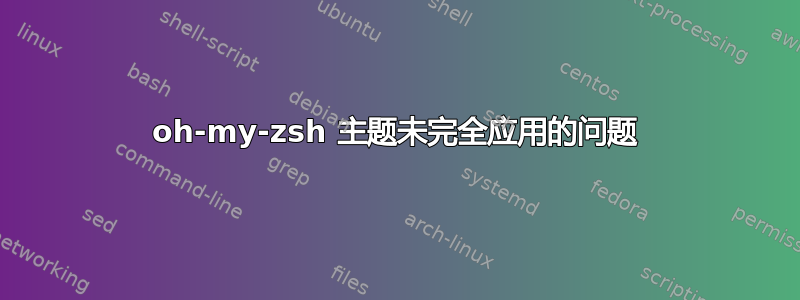
我对 zsh 和 askubuntu 都很陌生,所以请多包涵。:)
我正在经历这教程,但一直卡在“更改 Oh-My-ZSH 主题”部分。我可以通过编辑 .zshrc 并将 ZSH_THEME 更改为我想要的主题 (wuffers) 来应用主题,并且有些东西会发生变化,比如我创建新终端时显示的内容(第一行,不确定它叫什么)。小箭头会变成笑脸或其他小符号。但颜色、背景和字体永远不会改变,所以当我“ls”时,字体和颜色每次都一样。我通过“echo $ZSH_THEME”检查过,它返回了我应用的内容 (wuffers)。
以下是我尝试过的所有方法的列表:
- 获取我的 .zshrc 文件
- 将主题设置为随机并连续尝试几个,看看 wuffers 是否特别时髦(这不是孤立的,它发生在我尝试的每个主题上)
- 删除文件末尾的额外语法高亮插件
- 彻底删除我的 .zshrc 文件并从头开始
我发现这个问题在 GitHub 页面上,他们的问题似乎已经得到解决,但我不确定他们所说的包(“apt-get remove grml-zsh-config”?)到底是什么意思。所以这很可能就是我的问题的答案。
我正在运行最新的 Ubuntu 18.04.2。
我现在唯一的插件是 git(我试过删除它来看看是否有任何不同——没有)。
这是我的.zshrc 文件:
# If you come from bash you might have to change your $PATH.
# export PATH=$HOME/bin:/usr/local/bin:$PATH
# Path to your oh-my-zsh installation.
export ZSH="/home/legate/.oh-my-zsh"
# Set name of the theme to load --- if set to "random", it will
# load a random theme each time oh-my-zsh is loaded, in which case,
# to know which specific one was loaded, run: echo $RANDOM_THEME
# See https://github.com/robbyrussell/oh-my-zsh/wiki/Themes
ZSH_THEME="random"
# Set list of themes to pick from when loading at random
# Setting this variable when ZSH_THEME=random will cause zsh to load
# a theme from this variable instead of looking in ~/.oh-my-zsh/themes/
# If set to an empty array, this variable will have no effect.
# ZSH_THEME_RANDOM_CANDIDATES=( "robbyrussell" "agnoster" )
# Uncomment the following line to use case-sensitive completion.
# CASE_SENSITIVE="true"
# Uncomment the following line to use hyphen-insensitive completion.
# Case-sensitive completion must be off. _ and - will be interchangeable.
# HYPHEN_INSENSITIVE="true"
# Uncomment the following line to disable bi-weekly auto-update checks.
# DISABLE_AUTO_UPDATE="true"
# Uncomment the following line to automatically update without prompting.
# DISABLE_UPDATE_PROMPT="true"
# Uncomment the following line to change how often to auto-update (in days).
# export UPDATE_ZSH_DAYS=13
# Uncomment the following line if pasting URLs and other text is messed up.
# DISABLE_MAGIC_FUNCTIONS=true
# Uncomment the following line to disable colors in ls.
# DISABLE_LS_COLORS="true"
# Uncomment the following line to disable auto-setting terminal title.
# DISABLE_AUTO_TITLE="true"
# Uncomment the following line to enable command auto-correction.
# ENABLE_CORRECTION="true"
# Uncomment the following line to display red dots whilst waiting for completion.
# COMPLETION_WAITING_DOTS="true"
# Uncomment the following line if you want to disable marking untracked files
# under VCS as dirty. This makes repository status check for large repositories
# much, much faster.
# DISABLE_UNTRACKED_FILES_DIRTY="true"
# Uncomment the following line if you want to change the command execution time
# stamp shown in the history command output.
# You can set one of the optional three formats:
# "mm/dd/yyyy"|"dd.mm.yyyy"|"yyyy-mm-dd"
# or set a custom format using the strftime function format specifications,
# see 'man strftime' for details.
# HIST_STAMPS="mm/dd/yyyy"
# Would you like to use another custom folder than $ZSH/custom?
# ZSH_CUSTOM=/path/to/new-custom-folder
# Which plugins would you like to load?
# Standard plugins can be found in ~/.oh-my-zsh/plugins/*
# Custom plugins may be added to ~/.oh-my-zsh/custom/plugins/
# Example format: plugins=(rails git textmate ruby lighthouse)
# Add wisely, as too many plugins slow down shell startup.
plugins=(git)
source $ZSH/oh-my-zsh.sh
# User configuration
# export MANPATH="/usr/local/man:$MANPATH"
# You may need to manually set your language environment
# export LANG=en_US.UTF-8
# Preferred editor for local and remote sessions
# if [[ -n $SSH_CONNECTION ]]; then
# export EDITOR='vim'
# else
# export EDITOR='mvim'
# fi
# Compilation flags
# export ARCHFLAGS="-arch x86_64"
# Set personal aliases, overriding those provided by oh-my-zsh libs,
# plugins, and themes. Aliases can be placed here, though oh-my-zsh
# users are encouraged to define aliases within the ZSH_CUSTOM folder.
# For a full list of active aliases, run `alias`.
#
# Example aliases
# alias zshconfig="mate ~/.zshrc"
# alias ohmyzsh="mate ~/.oh-my-zsh
source /usr/share/zsh-syntax-highlighting/zsh-syntax-highlighting.zsh
任何帮助将不胜感激!
答案1
我认为颜色和字体是由终端仿真器本身而不是外壳决定的。
例如,在 Mac 终端中,使用另一组主题文件设置颜色,如下所示 -https://apple.stackexchange.com/questions/313132/how-can-i-change-my-font-and-coloring-in-oh-my-zsh-to-match-a-theme-i-want. 假设你正在使用 gnome 终端,你应该使用https://github.com/Mayccoll/Gogh改变颜色和字体等。
正如你在这里看到的https://github.com/robbyrussell/oh-my-zsh/blob/master/themes/wuffers.zsh-theme,主题定义只是修改了 shell 提示符(这就是该行的名称)。gnome 终端会解释术语“绿色”、“蓝色”、“红色”等。通过配置文件,您可以将绿色定义为黑色,将蓝色定义为白色等。


